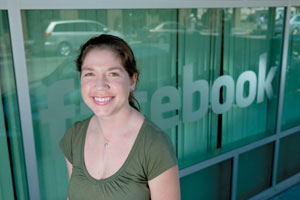November 16, 2009 - By Tracie White

Elizabeth Craze, 27, was one of the youngest patients to survive a heart transplant, performed at Stanford in 1984 when she was a toddler. She now works at Facebook.
On Oct. 8, 1984, the healthy heart of a little girl from Utah, the victim of a car crash, was transplanted into tiny Elizabeth Craze’s chest at Stanford Hospital at the tender age of 2 years and 10 months.
Twenty-five years later, Craze, who was one of the youngest heart transplant patients to survive during the early days of heart transplant surgery, celebrated the 25th anniversary of that heart transplant with a trip to Yosemite followed by a weekend cruise to Mexico.
“Yeah, it does feel like a big deal,” said 27-year-old Craze, an IT employee for Facebook in Palo Alto. “I was telling my friends last night that my mom cried when I bought my high school prom dress because she didn’t think I’d live that long. And now, I’ve made it longer.”
Craze has taken medications all her life, struggling with the drugs’ side effects that gave her hairy eyebrows during her teen years and resulted in a kidney transplant operation 11 years ago. But she looks and feels so healthy that friends are always shocked when they find out she’s had a heart transplant.
Six months ago at her annual checkup, doctors told her that everything “looks great.”
“You wouldn’t know there’s a thing wrong with her,” said Susan, her mother, who moved the family from Cleveland to the Peninsula to be near Stanford in 1989. Elizabeth’s older brother Andrew, 42, had the first heart transplant operation in the family, a year before Elizabeth, when he was 16. Today he’s a mechanical engineer living in Cleveland.
Because there was no Lucile Packard Children’s Hospital at the time, both Andrew and Elizabeth received their new hearts at Stanford Hospital.
“My brother-in-law was the first to tell us about Stanford and how Dr. (Norman) Shumway had continued the heart transplantation program even though so many medical facilities couldn’t do it,” Susan Craze said. “Stanford’s team was just so on top of everything. It was amazing.”
Forty years ago in 1968, the late Norman Shumway, MD, and a team of doctors performed the first successful heart transplant in the United States at Stanford Hospital on a 54-year-old steelworker from East Palo Alto amid an uproar of controversy and a media frenzy. Proving the naysayers and skeptics wrong, the landmark operation has since become almost routine, saving thousands of lives around the world.
In the early 1980s, heart transplantation, particularly for children, was still far from routine.
But there was no other choice for the Craze family, and the only place to go was Stanford.
“When I told my doctor in Cleveland we were considering heart transplantation, I can still picture him, backing up against the wall with just this look of horror on his face,” Susan Craze recalled.
Elizabeth was diagnosed with heart failure four months after her birth. Three of her siblings had previously died of heart failure in infancy. The fourth, her older brother Andrew, was diagnosed shortly after Elizabeth. At that time, it was thought to be a death sentence.
“I thought I would go absolutely insane,” said her mother.
When Elizabeth showed up at Stanford in need of a new heart, the primary question at the time was whether a donated heart would continue to grow along with her body. She was deathly ill and weighed only 23 pounds. An ethics committee was formed and, after listening to her brother’s pleas, the decision was made to go ahead with the operation.
“It was difficult trying to find a donor,” Susan Craze said. “It was really close whether she was going to make it another day.”
About Stanford Medicine
Stanford Medicine is an integrated academic health system comprising the Stanford School of Medicine and adult and pediatric health care delivery systems. Together, they harness the full potential of biomedicine through collaborative research, education and clinical care for patients. For more information, please visit med.stanford.edu.